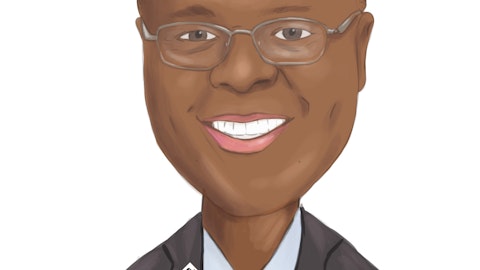Camden National Corporation (NASDAQ:CAC) Q1 2024 Earnings Call Transcript April 30, 2024
Camden National Corporation isn’t one of the 30 most popular stocks among hedge funds at the end of the third quarter (see the details here).
Operator: Good day, and welcome to Camden National Corporation’s First Quarter 2024 Earnings Conference Call. My name is Seb, and I’ll be your operator for today’s call. [Operator Instructions]. I will now turn the call over to Renee Smyth, Executive Vice President, Chief Experience and Marketing Officer.
Renee Smyth: Thank you, Seb. Good afternoon and welcome to Camden National Corporation’s conference call for the first quarter of 2024. Joining us this afternoon are members of Camden National Corporation’s Executive Team, Simon Griffiths, President and Chief Executive Officer; and Mike Archer, Executive Vice President and Chief Financial Officer. Please note that this presentation contains forward-looking statements and actual results could materially from what is discussed on today’s call. Cautionary language regarding these forward-looking statements is contained in our first quarter 2024 earnings release, which was issued this morning, as well as in other reports we file with the SEC. All these materials and public filings are available on our Investor Relations website at CamdenNational.bank.
Camden National Corporation trades on the NASDAQ under the symbol CAC. In addition, today’s presentation includes discussion of non-GAAP financial measures, any reference to non-GAAP financial measures are intended to provide meaningful insights and are reconciled with GAAP in our earnings release, which is also available on our Investor Relations website. I’m pleased to introduce Camden National Corporation’s host, President and Chief Executive Officer, Simon Griffiths.
Simon Griffiths : Thank you, Renee, and good afternoon everyone. And thank you for joining us on our call today. We sincerely appreciate your time and interest. I will give some comments and then Mike will dive into our first quarter performance, and then we’ll open up the call for Q&A. First, I would like to report as I’m now over 90 days into the role as President and Chief Executive Officer, I continue to be impressed with the depth and experience of the management team and the talented team members executing diligently throughout the organization. Each team member is focused on executing on our strategies, including growing our primary banking relationships and leveraging our position of strength. Earlier this morning, we reported net income of $13.3 million or $0.91 earnings per diluted share for the first quarter of 2024.
Overall, we are pleased with our quarterly financial results supported by strong capital, asset quality and liquidity. Our regulatory capital ratios continue to be well in excess of required regulatory levels and steadily grow, as we close the first quarter with a reported tangible common equity ratio of 7.12% up one basis point since year end. We continue to manage credit rigorously consistent with our discipline credit culture, which continues to serve us well. For the first quarter, we reported strong asset quality evidenced by non-performing assets at just 13 basis points of total assets. Our commercial loan portfolio remains well-balanced with no meaningful concentration risks. Our credit and special asset teams continue to proactively review our portfolio and have not found any systematic areas of concern.
For example, we continue to look at areas that interest rate risk in the context of rate resets or maturing loans, lease rollover in certain asset classes, and credit score migration amongst other early indicators. This is a testament to our significant due diligence efforts, strong relationships with our borrowers, and in-depth knowledge of the communities that we serve. As our credit team indicates our commercial customers have depth and character, which continues to fuel our strength. We continue to see moderate loan demand in our communities with our approved pipeline remaining reasonably consistent over the past few quarters. Our teams are developing new customers and relationships in both commercial and consumer categories. Expense control remains a key focus and was evident as non-interest expense for the first quarter of 2024 decreased 2% compared to the fourth quarter of 2023.
During this quarter, we took actions to maintain and manage cost and response to revenue pressure caused by decreasing net interest margin. This month, our wealth management leader, Jennifer, retired after nearly 40 years in the industry, and we welcomed Garrett McKnight to the executive team to lead our wealth transformation efforts. Garrett is a former Senior Managing Director at the Northern Trust Company and has more than 20 years of experience leading wealth management teams and serving clients and their families in the areas of investment management, financial planning, and fiduciary services. We’re incredibly excited to bolster our wealth management services by adding Garrett expertise and our recent launch of a new wealth mobile app and client portal to provide our clients with unprecedented access to market intelligence and portfolio insight anytime anywhere.

Our technology advancements also include a new state-of-the-art mobile and online account opening platform scheduled to go live at year end, allowing customers to open fund and use deposit accounts within minutes, whenever and wherever they choose. This is the latest milestone on our successful digital transformation roadmap further unifying our digital and in-person customer experience, and efforts to expand our customer base. In summary, although the financial services industry continues to face economic uncertainty, we are confident in our ability to adapt to the changing landscape and deliver solid returns through the current challenges. We are well-positioned to capitalize on exceptional customer relationships and are investing in our future.
Our confidence comes from having a clear strategic plan to drive profitable growth and having a talented team focused on executing it. Now, Mike will provide some first quarter highlights.
Mike Archer: Excellent. Thank you, Simon. Good afternoon, everyone. This morning we reported net income of $13.3 million and diluted earnings per share of $0.91 for the first quarter of 2024. Overall, we are pleased with these results as we continue to navigate through a challenging interest rate cycle. Net income for the first quarter was 57% higher than the last quarter and 4% higher than a year ago. On a non-GAAP basis, adjusted for realized investment losses and a $910,000 recovery on the sale of the Signature Bank bond that we previously wrote off in 2023, adjusted net income increased 1% over the fourth quarter of last year and decreased 11% compared to the first quarter of 2023. Our adjusted return on average assets was up one basis point to 0.88% for the first quarter of 2024 and our tangible capital continues to build highlighted by an increase in tangible book value per share of 1%, during the first quarter of 2024 and an increase of 10% over the past 12 months.
In the first quarter, our net interest margin decreased 10 basis points to 2.30%, which was lower than the expectations we communicated at our last earnings call. Funding costs on a linked-quarter basis increased 17 basis points to 2.27% for the first quarter and was a few basis points higher than anticipated. We experienced normal seasonal deposit outflows in our markets during the first quarter and we continue to see the remix from lower to higher-cost deposit products. Our attention continues to be on optimizing net interest margin to maintain and grow revenues and increase profitability. Through the first quarter, we continued to take calculated actions to optimize our balance sheet and net interest margin. A few examples include replacing higher cost deposits, which included $72 million of interest checking balances and $50 million of CDs with more cost-advantageous funding alternatives, including the bank term funding program, broker deposits and the balance sheet derivative.
As we look to the second quarter, we currently anticipate net interest margin will hold at or around 2.30% with possible upside as certain balance sheet derivatives mature in early June and we anticipate normal seasonal deposit inflows picking up towards the back half of the second quarter. In response to continued pressure on our net interest margin, we took actions during the first quarter to manage expenses closely. In doing so, we are able to manage expenses lower on a linked-quarter basis by 2% to $27.4 million, which is well below our previously communicated expense forecast for the first quarter of $28 million to $28.5 million. As we look forward, we do anticipate operating expenses will trend slightly higher for the rest of the year and closer inline with prior guidance.
In the first quarter loans grew 1%, driven by commercial real estate loan balances increasing by $30.6 million. We continue to be disciplined with loan pricing across our products in the current interest rate environment. Based on our current loan pipeline and strategy, we currently anticipate similar loan growth and a mix for the second quarter. Our asset quality for the first quarter continued to be very strong supported by excellent credit quality metrics, including non-performing loans of 0.19% of total loans, annualized net charge offs of 2 basis points of average loans and past two loans of five basis points of total loans. The strength of our current and past asset quality combined with modest loan growth and internal stress testing we have performed on certain loan segments, gave us the confidence to reduce our loan loss reserves to 0.86% of total loans at March 31st.
This resulted in a credit for loan losses of $1.2 million for the first quarter and combined with the $910,000 recovery on the signature bank bond, we recognize a total negative provision of expense of $2.1 million for the first quarter. Our capital liquidity positions also continue to be strong. Our book and regulatory capital ratio has improved across the board in the first quarter. Our tangible common equity ratio was 7.12% at March 31st, 2024 compared to 7.11% at December 31st, 2023, and 6.56% at March 31st 2023. Our uninsured and uncollateralized deposits at March 31st, 2024 were 14.8% of total deposits and our available liquidity sources were 2.1 times uninsured and uncollateralized deposits, which continues to be very consistent with previous periods.
This concludes our comments. We’ll now open the call up for questions.
See also 24 Profitable Outdoor Business Ideas to Start In 2024 and 12 ChatGPT Penny Stock Picks Right Now.
Q&A Session
Follow Camden National Corp (NASDAQ:CAC)
Follow Camden National Corp (NASDAQ:CAC)
Receive real-time insider trading and news alerts
Operator: [Operator Instructions] Our first question comes from Steve Moss from Raymond James. Please go ahead.
Steve Moss: Maybe just starting with loan pricing here. Curious as to what you’re seeing getting for loan pricing in your markets these days. And also, along that front I noticed commercial loans went down by about 20 base points in yield quarter, quarter. Just kind of curious what if there’s anything unique there?
Mike Archer : Just on your first part there, in terms of loan pricing, what we’re currently seeing, we continue to hold really pretty steady in terms of keeping rates are keeping some of our interest rates higher. We originated, I think for the quarter in the neighborhood of 7.5% to 8% was our origination yield and our pipelines continue to be right in that neighborhood too, Steve. So, we continue to be very focused on that and where we can getting that price and being disciplined. On the second piece there, for the — sorry. Go ahead Steve.
Steve Moss: No, go ahead Mike. I’m sorry.
Mike Archer : I was going to say on the C&I piece, we did have one syndication loan that essentially repriced or refinanced rather during the quarter, and that’s the primary driver for the C&I decrease. But nothing really atypical or abnormal there.
Steve Moss: And then in terms of the derivatives you referenced, Mike, it sounds like you added some during the quarter, and then just what do you have mature come June, just to kind of help with some of the puts and takes of the balance sheet moves here?
Mike Archer : We actually executed the derivative in the December timeframe. I think it was with a forward start in January. I want say it was either 50 or 75 million off the top of my head. Really with the sole idea of replacing that more expensive CD that we had mentioned that was 50 million. Just again, trying to be advantageous in terms of funding costs where we can. And then in terms of the derivatives rolling off in the June timeframe, essentially, we have a hundred million of balance sheet swaps. They’ve been on our books for quite some time and that really has been compressing some of our Cree yields that are showing up in our margin tables. So, we do anticipate those rolling off a year and we do anticipate that should provide six, seven basis points to margin on a go forward basis once we get past that point.
Steve Moss: Basically, kind of the margin, if rate’s kind of holding this range, 230ish this quarter and then, some upside as we head into the third quarter.
Mike Archer: Yes, I think that’s a fair summary.
Steve Moss: Okay. Appreciate that. In terms of — just on the mortgage side here, you guys, I saw sold more mortgages this quarter. Just kind of curious, your appetite or the business mix, should we think about just higher volumes given more saleable production here going forward?
Simon Griffiths : Yes. Hey, Steve, its Simon. I’d say overall, low single digit growth is where we’re seeing it. We continue to see nice demand on the resi side, which is continues to reflect I think the strength of the economy and the, and the consumer in general. So certainly, modest growth and that’s sort of how we’re positioning that within our loan growth. But certainly, continue to see some strong demand out there.
Steve Moss: Appreciate that. And then also Simon, just with regard to the reserve release, and I heard the reference about a deeper diving in credit, just curious, it gives a little more color as to how you looked at buckets and, and just the dynamics that maybe gave some comfort around the reserve release this quarter and should we expect any more reviews in the upcoming quarter or two?
Simon Griffiths : Yes, I think look at it — as we talked about in the opening remarks, we just have a very strong, credit portfolio and see just very strong performance and continue to stress test. I think the team identified this opportunity. I think going forward, we’re going to just look at it as a case by case, but certainly felt this quarter certainly made sense. Obviously, the outlook for the rest of the year I think is a key driver of how that potentially could change. And there’s obviously a lot of uncertainty right now in terms of the back half of the year, but I think overall the team feels just the credit position’s a very strong position and we felt it was appropriate for a release on this quarter. Mike, you want to add anything?
Mike Archer: Yes, I would just say specifically our credit, excuse me, our credit risk team really dove into some of the, I’ll call it some of the problem headline areas that we’re seeing in the news around rent controls and some of the interest only loans and so forth, Steve, just as examples and stressing debt service and LTVs and other factors there from an interest rate perspective, we just felt really, we continued to have a very strong book. We’re not seeing anything systemic or any material issues there across those portfolios. And I think just coupled with, like I said in commentary is where we’ve been and how we’ve performed combined with our own stress testing and how we’re continuing to monitor, we just felt it was prudent and appropriate at this time to release some of the reserves. But we’ll continue to monitor and if macroeconomic factors change, et cetera, we’ll adjust accordingly, but certainly we feel very good at this level.
Operator: Our next question comes from Damon DelMonte from KBW. Please go ahead.
Damon DelMonte: Just to kind of follow up on the questioning on the credit and provision outlook. If you’re expecting kind of like low single digit loan growth absent any net charge offs, should we expect a little bit of provisioning just to cover the new loan growth? And if so, like what would be a like kind of a targeted reserve you guys would be putting on new loans that come on the books?




